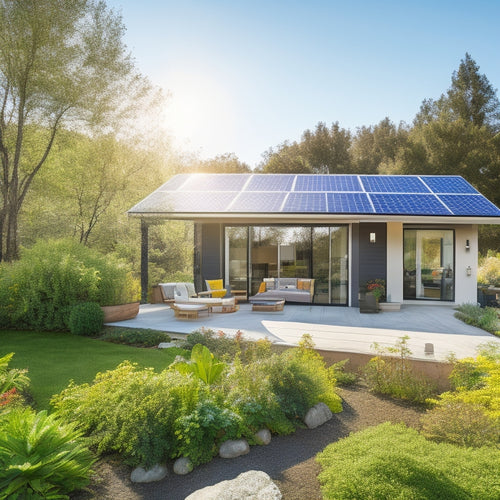
What to Do When Your Panels Need TLC
Share
When your panels need TLC, start by performing a visual inspection for cracks, chips, or dirt buildup. After severe weather, recheck for any damage. Clean your panels with a soft-bristle brush, mild biodegradable soap, and distilled water. Always use non-abrasive materials and work in sections to avoid oversaturation. Check for shading from new growths and secure loose wiring connections. Turn off the system before cleaning for safety. Regular, safe maintenance and minor repairs like tightening connections guarantee peak efficiency and longevity. Curious about the best tools and techniques for maintenance?
Key Takeaways
- Conduct visual inspections for damage, dirt buildup, and shading.
- Clean panels regularly using soft-bristle brushes and eco-friendly solutions.
- Check and secure wiring connections to prevent energy loss.
- Inspect for and address physical damage like cracks or discoloration.
- Perform preventative maintenance to enhance performance and lifespan.
Inspecting Your Solar Panels
https://www.youtube.com/watch?v=p6kxVswaY1g
To guarantee peak performance and longevity of your solar panels, start by conducting a thorough visual inspection for any visible damage or dirt buildup. Begin by examining the panel surface for cracks, chips, or other physical damage, as these can greatly impact efficiency. Weather impact, such as hail, strong winds, or heavy snow, can cause such damage over time, so it's essential to inspect after severe weather events.
Next, check for installation errors. Misaligned panels, loose mounts, or exposed wiring can compromise both performance and safety. Make sure that all panels are securely fastened and correctly positioned to maximize sun exposure. Pay attention to any shading caused by new tree growth or structural changes around your installation site.
Inspect the connectors and wiring for signs of wear or corrosion. Faulty connections can lead to energy loss or potentially hazardous situations. Look for discoloration, frayed wires, or loose connections that need tightening or replacement.
Cleaning Tools You'll Need
Acquiring the appropriate cleaning tools is crucial for maintaining the efficiency and longevity of your solar panels. First, focus on selecting the right brush types. A soft-bristle brush is your best ally; it effectively removes dust and grime without scratching the delicate surface of your panels. Avoid using abrasive materials that could cause permanent damage.
Next, let's talk about soap recommendations. Opt for a mild, biodegradable soap. Harsh chemicals can corrode the surface and reduce your panels' efficiency. A gentle soap, combined with a soft brush, guarantees that you clean the panels without harming them or the environment.
You'll also need a squeegee to remove any soapy residue and excess water, preventing streaks and spots. A long-handled squeegee can help you reach the highest panels without risking your safety.
Finally, always use distilled water for rinsing. Tap water contains minerals that can leave deposits on your panels, affecting their performance. Distilled water ensures a spotless finish.
Equipped with these tools, you're ready to keep your solar panels in peak condition. Remember, investing in the right cleaning instruments not only prolongs the life of your panels but also maximizes their energy output.
Safe Cleaning Techniques
When cleaning your panels, always use gentle cleaning materials to avoid damaging the surface. Make sure to employ proper cleaning tools like soft brushes and non-abrasive cloths.
It's important to establish a regular cleaning frequency to maintain peak efficiency and longevity of your panels.
Gentle Cleaning Materials
Ensuring your panels remain in peak condition starts with selecting gentle cleaning materials that won't harm their surfaces. Begin by using non-abrasive sponges to avoid scratching or damaging the panel's delicate finish. These sponges are specifically designed to lift dirt and grime without causing any surface abrasions, making them ideal for maintaining the aesthetic and functional integrity of your panels.
Next, opt for distilled water as your primary cleaning agent. Distilled water is free from impurities and minerals that can leave behind residues or cause corrosion over time. By using distilled water, you guarantee that the cleaning process is as essential and effective as possible, preserving the longevity and efficiency of your panels.
When applying the distilled water, lightly dampen the non-abrasive sponge and gently wipe the surface of the panel. Avoid excessive moisture, as too much liquid can seep into the panel's components and cause damage.
It's vital to follow a methodical approach, working in small sections to guarantee thorough cleaning without oversaturating the material.
Proper Cleaning Tools
Using the proper cleaning tools is essential to guarantee your panels are maintained safely and effectively. Selecting the right tools not only ensures peak performance but also extends the lifespan of your panels. Prioritizing safety and efficiency, here's what you need:
-
Soft Bristle Brushes: Gentle on the panel surface, these prevent scratches while effectively removing debris.
-
Non-Abrasive Sponges: Ideal for wiping without causing damage, perfect for delicate surfaces.
-
Squeegee with Extension Pole: Allows you to reach higher panels safely, ensuring thorough cleaning without risking injury.
-
Microfiber Cloths: Highly effective for a streak-free finish, excellent for drying and buffing.
-
Eco-Friendly Cleaning Solutions: Safe for the environment and your panels, these solutions don't leave harmful residues.
Store your tools in a clean, dry place to maintain their effectiveness. Proper storage is essential for prolonging their lifespan and ensuring they're ready for use during seasonal upkeep.
Be conscious of your cleaning technique: always apply gentle pressure and avoid harsh chemicals. This approach not only preserves your panels but also liberates you from the stress of frequent replacements or repairs.
Frequency of Cleaning
Determining the best frequency for cleaning your panels is vital to maintaining their efficiency and longevity. Cleaning frequency should be tailored to your specific environment. If you live in an area with high pollution levels, frequent dust storms, or heavy bird activity, you'll need to clean more often, possibly every three to six months. In less polluted areas, an annual cleaning might suffice.
Environmental impact is an important factor when deciding how often to clean. Using excessive water or harsh chemicals can harm local ecosystems. Opt for eco-friendly cleaning solutions and methods to minimize your impact. For instance, use biodegradable soap and a soft brush or a low-pressure hose for rinsing, ensuring that runoff doesn't contaminate nearby soil or water sources.
Ensure safety by turning off your system before cleaning. Wear non-slip shoes and use a secure ladder if your panels are roof-mounted. Always inspect the panels and mounting hardware for any damage before you begin.
Regular, safe maintenance not only boosts your system's performance but also extends its lifespan, allowing you to enjoy a sustainable, efficient energy source with minimal environmental impact.
Addressing Common Issues
When your panels start showing signs of wear, it's important to diagnose the problem promptly to maintain their efficiency and safety. Common issues can range from minor dirt accumulation to more serious electrical faults. Here's how you can address some of these concerns effectively.
First, check the panel orientation. Panels not facing the best direction can lose efficiency. Make sure they're aligned properly to capture maximum sunlight.
Next, inspect for bird nests or droppings. Birds love nesting near panels, and this can block sunlight and damage wiring. Installing bird deterrents can mitigate this issue.
Regular inspections are essential. Look for cracks, discoloration, or cloudiness on the panel surface. These could indicate physical damage or internal issues. Also, ensure that the wiring connections are secure and free from corrosion. Loose or corroded wires can lead to energy loss or even safety hazards.
To make your task easier, here's a checklist:
- Check panel orientation: Ensure sunlight capture is at its best.
- Install bird deterrents: Prevent nesting and droppings.
- Inspect for surface damage: Look for cracks and discoloration.
- Secure wiring connections: Prevent energy loss and hazards.
- Monitor performance metrics: Use monitoring tools for efficiency.
DIY Minor Repairs
Start by inspecting your panels for any visible damage such as cracks or discoloration.
Verify all connections are secure by tightening any loose screws or terminals.
Always turn off the power supply before performing these tasks to prioritize your safety.
Inspect for Visible Damage
Regularly inspect your panels for visible damage, such as cracks, discoloration, or loose connections, to guarantee they function safely and efficiently. Begin by looking for visible cracks, which can compromise the structural integrity and efficiency of your panels. Be mindful of weather damage, as prolonged exposure to harsh conditions can lead to discoloration, rust, or other forms of deterioration.
When conducting your inspection, consider the following steps:
-
Check for discoloration: Examine the surface for any unusual color changes, which may indicate overheating or chemical damage.
-
Inspect for cracks: Look closely at the panels for any visible cracks that might allow moisture to penetrate and cause further damage.
-
Assess weather damage: Pay attention to signs of corrosion, rust, or other effects caused by prolonged exposure to rain, snow, or extreme temperatures.
-
Examine seals and edges: Confirm that all seals and edges are intact and free from wear that could allow water ingress.
-
Look for loose connections: Identify any components that appear loose, as they may need tightening to ensure proper function.
Tighten Loose Connections
Guarantee the safety and efficiency of your panels by tightening any loose connections you identify during your inspection. Loose connections can lead to connection hazards, including overheating and potential electrical fires.
Begin by making sure the system is powered down to avoid any risk of electric shock. Use a voltage tester to confirm there's no live current running through the wires.
Next, examine all wiring terminals and screws. Use a screwdriver to snug them up, but don't over-tighten, as excessive force could damage the connectors. Check for any signs of wear or corrosion, as these issues can also compromise safety and efficiency. Replace any visibly damaged components immediately.
If you encounter any connections that are excessively worn, corroded, or damaged beyond simple tightening, it's important to seek professional help. A certified electrician can safely handle extensive repairs and ensure your system operates efficiently.
Preventative Maintenance Tips
Securing the longevity of your panels involves conducting routine inspections and timely cleanings to prevent buildup and damage. Regular preventative maintenance can save you from costly repairs and guarantee peak performance. Start by monitoring performance metrics to identify any efficiency drops, which can indicate underlying issues. Weather considerations also play a huge role; panels exposed to harsh conditions may require more frequent checks.
Here are some tips to help you maintain your panels effectively:
-
Inspect for Debris: Regularly check for leaves, dirt, and other debris on the panels. Clean them gently with a soft brush or sponge.
-
Check for Shading: Ensure no new structures or foliage are casting shadows on your panels, as this can greatly reduce efficiency.
-
Monitor Output: Use a monitoring system to track energy output. Sudden drops might suggest a need for maintenance.
-
Examine Wiring and Connections: Periodically inspect wiring and connections for signs of wear or corrosion. Tighten loose connections as needed.
-
Weatherproofing: Ensure seals and weatherproofing materials are intact to protect against moisture and extreme temperatures.
Frequently Asked Questions
How Often Should I Professionally Service My Solar Panels?
You should professionally service your solar panels annually. Establish a cleaning schedule and conduct performance checks to guarantee peak efficiency and safety. Regular maintenance liberates you from unexpected issues and maintains energy independence.
Can Extreme Weather Damage Solar Panels?
Extreme weather can indeed damage solar panels. Hail damage can crack the surface, while wind impact may dislodge or misalign them. Regular inspections guarantee peak performance and safety, empowering you to harness solar energy freely.
Is It Safe to Walk on Solar Panels?
Walking on solar panels isn't safe due to risks of damage and personal injury. To maintain panel durability, use proper cleaning techniques like soft brushes and gentle rinsing to guarantee efficiency and extend their lifespan.
What Are the Costs Associated With Major Solar Panel Repairs?
Major solar panel repairs can cost an arm and a leg. You'll need to take into account the repair warranty and potential inverter replacement. Costs vary, but budgeting for these can save you from unexpected expenses and keep your system efficient.
How Can I Improve My Solar Panel Efficiency?
To improve your solar panel efficiency, regularly perform panel cleaning to remove debris and dirt. Implement effective shade management by trimming nearby trees. Safety first: always turn off systems before maintenance to avoid electrical hazards.
Related Posts
-

Green Home Improvements Using Solar Power
Investing in solar power alters your home into a sustainable haven while slashing energy costs. You can greatly reduc...
-

Solar Power Backup Solutions During Outages
Solar power backup solutions guarantee you have reliable energy during outages, providing essential power when the gr...
-

How to Reduce Home Energy Bills
To reduce your home energy bills, start by investing in energy-efficient appliances and upgrading your insulation. Lo...


